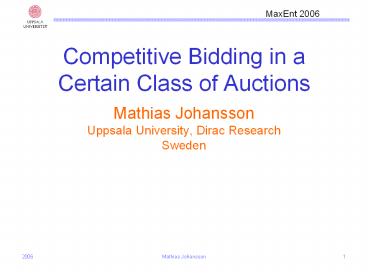Competitive Bidding in a Certain Class of Auctions
Title:
Competitive Bidding in a Certain Class of Auctions
Description:
Competitive Bidding in a Certain Class of Auctions. Mathias Johansson ... Let qu be the bid per unit resource of user u, cu the corresponding capacity ... –
Number of Views:24
Avg rating:3.0/5.0
Title: Competitive Bidding in a Certain Class of Auctions
1
Competitive Bidding in a Certain Class of Auctions
- Mathias JohanssonUppsala University, Dirac
ResearchSweden
2
Problem background
- Fixed pricing is used today in mobile data
networks (such as GSM, 3G) - Could automatic mechanisms for dynamic pricing be
used to obtain a desired service level? - Why shouldnt prices reflect supply/demand?
- Radio channels fluctuate strongly and
unpredictably
3
Problem background
- Quality of service (QoS) requirements differ
among users - Typically defined in terms of throughput and
delay requirements - Streaming media requires tight service levels
- An automatic auctioning procedure could be used
in order to obtain desired QoS
4
The rules of the auction
- The resource can be used by only one user at a
time - For each user the resource carries a certain
utility, the user-specific capacity of the
resource - Each user submits one sealed bid to the
auctioneer, stating - the price the user is willing to pay per unit
resource, and - the users capacity
5
Auction set-up
- The winning total bid (bid per unit resource
times the capacity) obtains the resource for a
specific period of time - This process is repeated many times
- Different bidders may have different capacities
- Bids and capacities of other users are hidden
- Future capacities are typically uncertain at the
time of the bid
6
Whats the best bid?
- Each user determines the probability for winning
and a loss function reflecting the value of the
resource. - Clearly, some information of past auctions must
be given to the users - The average winning price-capacity product will
be announced along with its sample variance over
a given time - This is announced after every lth auction
7
User us probability for winning
- Let qu be the bid per unit resource of user u, cu
the corresponding capacity - If v is the user with the largest bid-capacity
product among all users except u, the probability
for winning is P(qvcv lt qucu cu,qu,I) - If cu is uncertain, we must also marginalize over
cu
8
User us probability for winning
- The probability for user u to win is thuswhere
y cvqv. - But how do we assign P(ycu,qu, I)?
9
Probability assignments
- P(cu I)
- We assume that cu can only take one of K possible
values. - Assuming that our only further information is a
past history of how many times the K different
levels have ocurred, Laplaces rule of succession
applies
10
Probability assignments
- P(y cu qu I)
- Only the mean winning bid-capacity product and
its sample variance is known - According to the maximum entropy principle, we
assign a Gaussian distribution. - Note! The announced information regards all
users, but y should not include user u - A correction is made by subtracting the
contributions from us wins.
11
Typical loss functions
- Constant throughput
- A user wants ?u resource units per time
unitwhere xu (qu) is the obtained throughput - Price-performance ratio
- A user may want to raise her bid if that results
in a substantially better throughput (i.e.
stockpiling when capacity is cheap)
12
Price-performance criterion
- A possible formalization isi.e. a price
increase of 1 unit is ok if the throughput
increases by a factor of a. If the throughput is
less than b, the resource is of no value.
13
Expectations and computations
- The expected constant throughput loss is
- The expected price-performance loss is
approximated by
14
Examples
- 4 users
- Every 20th time unit, mean-variance information
is broadcast and bids are updated - 4 different possible capacities, c0, 74, 92,
106 - Rate probabilities are updated by Laplaces rule
(rates are generated as Gaussian numbers with avg
80, std dev 20) - All users have a maximum bid per unit 5.
15
Example 1
- Constant rate loss for all users
- ?1 15, ?2 20, ?3 20, ?4 30,
- Resulting average throughput over 600 time units
(30 price updates) - x1 14, x2 21, x3 21, x4 33,
- More competitive setting
- ?1 15, ?2 20, ?3 25, ?4 30,
- x1 13, x2 19, x3 26, x4 31,
- and the average paid price per bit nearly doubles
16
Example 2
- Price-performance loss for user 1 and constant
rate loss for users 2-4 - ?2 10, ?3 20, ?4 20,
- Resulting average throughput
- x1 34, x2 11, x3 21, x4 21.
17
Evolution of bids
Throughput per time unit
18
Price-to-throughput ratio
19
Comments
- Bidding can be used to satisfy QoS demands
- But what are the long-term customer reactions?
- Other types of bidding situations call for
Bayesian treatment! - Challenge (MaxEnt 2007?) What is the expected
winning bid in the sale of an apartment given
knowledge of existing bid history? - Previous bids 500k, 550k, and 565k
- How would you, as a devoted Bayesian, bid?































